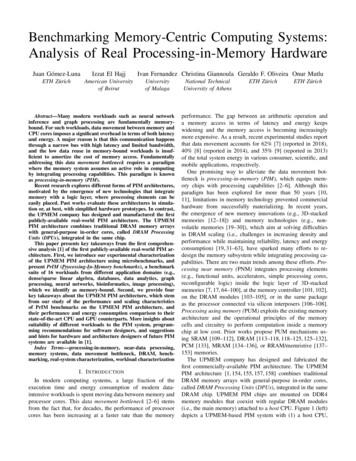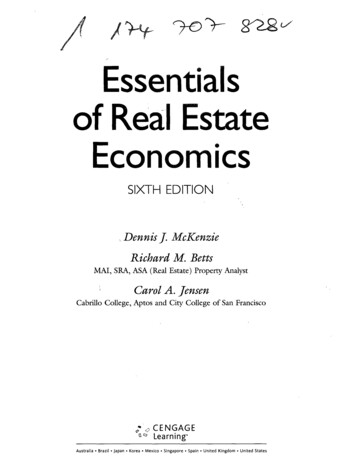
Transcription
Benchmarking Memory-Centric Computing Systems:Analysis of Real Processing-in-Memory HardwareJuan Gómez-LunaIzzat El HajjETH ZürichAmerican Universityof BeirutIvan Fernandez Christina Giannoula Geraldo F. Oliveira Onur MutluUniversityof MalagaAbstract—Many modern workloads such as neural networkinference and graph processing are fundamentally memorybound. For such workloads, data movement between memory andCPU cores imposes a significant overhead in terms of both latencyand energy. A major reason is that this communication happensthrough a narrow bus with high latency and limited bandwidth,and the low data reuse in memory-bound workloads is insufficient to amortize the cost of memory access. Fundamentallyaddressing this data movement bottleneck requires a paradigmwhere the memory system assumes an active role in computingby integrating processing capabilities. This paradigm is knownas processing-in-memory (PIM).Recent research explores different forms of PIM architectures,motivated by the emergence of new technologies that integratememory with a logic layer, where processing elements can beeasily placed. Past works evaluate these architectures in simulation or, at best, with simplified hardware prototypes. In contrast,the UPMEM company has designed and manufactured the firstpublicly-available real-world PIM architecture. The UPMEMPIM architecture combines traditional DRAM memory arrayswith general-purpose in-order cores, called DRAM ProcessingUnits (DPUs), integrated in the same chip.This paper presents key takeaways from the first comprehensive analysis [1] of the first publicly-available real-world PIM architecture. First, we introduce our experimental characterizationof the UPMEM PIM architecture using microbenchmarks, andpresent PrIM (Processing-In-Memory benchmarks), a benchmarksuite of 16 workloads from different application domains (e.g.,dense/sparse linear algebra, databases, data analytics, graphprocessing, neural networks, bioinformatics, image processing),which we identify as memory-bound. Second, we provide fourkey takeaways about the UPMEM PIM architecture, which stemfrom our study of the performance and scaling characteristicsof PrIM benchmarks on the UPMEM PIM architecture, andtheir performance and energy consumption comparison to theirstate-of-the-art CPU and GPU counterparts. More insights aboutsuitability of different workloads to the PIM system, programming recommendations for software designers, and suggestionsand hints for hardware and architecture designers of future PIMsystems are available in [1].Index Terms—processing-in-memory, near-data processing,memory systems, data movement bottleneck, DRAM, benchmarking, real-system characterization, workload characterizationI. I NTRODUCTIONIn modern computing systems, a large fraction of theexecution time and energy consumption of modern dataintensive workloads is spent moving data between memory andprocessor cores. This data movement bottleneck [2–6] stemsfrom the fact that, for decades, the performance of processorcores has been increasing at a faster rate than the memoryNational TechnicalUniversity of AthensETH ZürichETH Zürichperformance. The gap between an arithmetic operation anda memory access in terms of latency and energy keepswidening and the memory access is becoming increasinglymore expensive. As a result, recent experimental studies reportthat data movement accounts for 62% [7] (reported in 2018),40% [8] (reported in 2014), and 35% [9] (reported in 2013)of the total system energy in various consumer, scientific, andmobile applications, respectively.One promising way to alleviate the data movement bottleneck is processing-in-memory (PIM), which equips memory chips with processing capabilities [2–6]. Although thisparadigm has been explored for more than 50 years [10,11], limitations in memory technology prevented commercialhardware from successfully materializing. In recent years,the emergence of new memory innovations (e.g., 3D-stackedmemories [12–18]) and memory technologies (e.g., nonvolatile memories [19–30]), which aim at solving difficultiesin DRAM scaling (i.e., challenges in increasing density andperformance while maintaining reliability, latency and energyconsumption) [19, 31–63], have sparked many efforts to redesign the memory subsystem while integrating processing capabilities. There are two main trends among these efforts. Processing near memory (PNM) integrates processing elements(e.g., functional units, accelerators, simple processing cores,reconfigurable logic) inside the logic layer of 3D-stackedmemories [7, 17, 64–100], at the memory controller [101, 102],on the DRAM modules [103–105], or in the same packageas the processor connected via silicon interposers [106–108].Processing using memory (PUM) exploits the existing memoryarchitecture and the operational principles of the memorycells and circuitry to perform computation inside a memorychip at low cost. Prior works propose PUM mechanisms using SRAM [109–112], DRAM [113–118, 118–125, 125–132],PCM [133], MRAM [134–136], or RRAM/memristive [137–153] memories.The UPMEM company has designed and fabricated thefirst commercially-available PIM architecture. The UPMEMPIM architecture [1, 154, 155, 157, 158] combines traditionalDRAM memory arrays with general-purpose in-order cores,called DRAM Processing Units (DPUs), integrated in the sameDRAM chip. UPMEM PIM chips are mounted on DDR4memory modules that coexist with regular DRAM modules(i.e., the main memory) attached to a host CPU. Figure 1 (left)depicts a UPMEM-based PIM system with (1) a host CPU,
PIM ChipMain MemoryDDR4 InterfaceDRAM DRAM DRAM DRAM DRAM DRAM DRAM DRAMChipChipChipChipChipChipChipChipRegister ChipPIMChipPIMChipPIMChipPIM-enabled -KBWRAMDMA EngineDRAM DRAM DRAM DRAM DRAM DRAM DRAM tCPUUCPControl/Status Interface64 bits64-MBDRAMBank(MRAM)x8Figure 1: UPMEM-based PIM system with a host CPU, standard main memory, and PIM-enabled memory (left), andinternal components of a UPMEM PIM chip (right) [154, 155].of the UPMEM-based PIM system using microbenchmarks toassess various architecture limits such as compute throughputand memory bandwidth, yielding new insights. Second, wepresent PrIM (Processing-In-Memory benchmarks), an opensource benchmark suite [156] of 16 workloads from differentapplication domains (e.g., neural networks, databases, graphprocessing, bioinformatics), which we identify as memorybound workloads using the roofline model [159] (i.e., theseworkloads’ performance in conventional processor-centric architectures is limited by memory access). Table I shows asummary of PrIM benchmarks, including workload characteristics (memory access pattern, computation pattern, communication/synchronization needs) that demonstrate the diversityof the benchmarks.Our comprehensive analysis [1, 157] evaluates the performance and scaling characteristics of PrIM benchmarks on theUPMEM PIM architecture, and compares their performanceand energy consumption to their CPU and GPU counterparts.Our extensive evaluation conducted on two real UPMEMbased PIM systems with 640 and 2,556 DPUs provides newinsights about suitability of different workloads to the PIMsystem, programming recommendations for software designers, and suggestions and hints for hardware and architecturedesigners of future PIM systems.In this paper, we provide four key takeaways that repre-(2) main memory (DRAM memory modules), and (3) PIMenabled memory (UPMEM modules). PIM-enabled memorycan reside on one or more memory channels.Inside each UPMEM PIM chip (Figure 1 (right)), there are 8DPUs. Each DPU has exclusive access to (1) a 64-MB DRAMbank, called Main RAM (MRAM), (2) a 24-KB instructionmemory, and (3) a 64-KB scratchpad memory, called WorkingRAM (WRAM). The MRAM banks are accessible by the hostCPU for copying input data (from main memory to MRAM)and retrieving results (from MRAM to main memory). Thesedata transfers can be performed in parallel (i.e., concurrentlyacross multiple MRAM banks), if the size of the bufferstransferred from/to all MRAM banks is the same. Otherwise,the data transfers happen serially. There is no support for directcommunication between DPUs. All inter-DPU communicationtakes place through the host CPU by retrieving results andcopying data.Rigorously understanding the UPMEM PIM architecture,the first publicly-available PIM architecture, and its suitabilityto various workloads can provide valuable insights to programmers, users and architects of this architecture as wellas of future PIM systems. To this end, our work [1, 157]provides the first comprehensive analysis of the first publiclyavailable real-world PIM architecture. We make two key contributions. First, we conduct an experimental characterizationTable I: PrIM benchmarks [156].DomainDense linear algebraSparse linear algebraDatabasesData analyticsGraph processingNeural networksBioinformaticsImage processingParallel primitivesBenchmarkShort nameVector AdditionMatrix-Vector MultiplySparse Matrix-Vector MultiplySelectUniqueBinary SearchTime Series AnalysisBreadth-First SearchMultilayer PerceptronNeedleman-WunschImage histogram (short)Image histogram (long)ReductionPrefix sum (scan-scan-add)Prefix sum (reduce-scan-scan)Matrix LREDSCAN-SSASCAN-RSSTRNSMemory access patternSequential Strided sYesYesYesYesYesYesYesYesYes2Computation patternOperationsDatatypeaddint32 tadd, muluint32 tadd, mulfloatadd, compareint64 tadd, compareint64 tcompareint64 tadd, sub, mul, divint32 tbitwise logicuint64 tadd, mul, compareint32 tadd, sub, compareint32 tadduint32 tadduint32 taddint64 taddint64 taddint64 tadd, sub, mulint64 ndshake, barrierhandshake, barrierYesYesbarrier, mutexYesbarrierbarrierbarrier, mutexbarrierhandshake, barrierhandshake, barriermutexYesYesYesYesYesYes
Key Takeaway #2. The workloads most well-suited forthe UPMEM PIM architecture are those with simple orno arithmetic operations. This is because DPUs includenative support for only integer addition/subtraction and bitwise operations. More complex integer (e.g., multiplication,division) and floating point operations are implemented usingsoftware library routines. As Figure 3 shows, the arithmeticthroughput of more complex integer operations and floatingpoint operations are an order of magnitude lower than that ofsimple addition and 2119876543211611101465432813121579170(a) INT32 (1 9212301357911131517192123#Tasklets6(c) FLOAT (1 DPU)54ADDSUBMULDIV321(d) DOUBLE (1 ic Throughput (MOPS)Arithmetic Throughput (MOPS)ADDSUBMULDIV30#Tasklets6(b) INT64 (1 DPU)#Tasklets1357911131517192123Arithmetic Throughput 413121615141312151311111110101010109 119 1199 11988 101016151413121198 97 87 87 877 8766666 66 75555554 544441016151413121198765444 3 3 3 3 3 3 3101615141312119876543 32 2 2 2 2 2 22210168765415141312119321 1 1 1 1 1 11 1101615141312119 18765432101615141312119 370INT32, ADD (1 DPU)264.0032.001/4091/ 62041/ 81021/ 45121/2561/1281/641/321/161/81/41/21Arithmetic Throughput (MOPS, log scale)II. K EY TAKEAWAYSWe present several key empirical observations in the formof four key takeaways that we distill from our experimentalcharacterization of the UPMEM PIM architecture [1]. Wealso provide analyses of workload suitability and good programming practices for the UPMEM PIM architecture, andsuggestions for hardware and architecture designers of futurePIM systems.Key Takeaway #1. The UPMEM PIM architecture isfundamentally compute bound. Our microbenchmark-basedanalysis shows that workloads with more complex operationsthan integer addition fully utilize the instruction pipelinebefore they can potentially saturate the memory bandwidth.As Figure 2 shows, even workloads with as simple operationsas integer addition saturate the compute throughput with anoperational intensity as low as 0.25 operations/byte (1 additionper integer accessed).Arithmetic Throughput (MOPS)sent the main insights and conclusions of our work [1, 157].For more information about our thorough PIM architecturecharacterization, methodology, results, insights, and the PrIMbenchmark suite, we refer the reader to the full version of thepaper [1, 157]. We hope that our study can guide programmerson how to optimize software for real PIM systems andenlighten designers about how to improve the architecture andhardware of future PIM systems. Our microbenchmarks andPrIM benchmark suite are publicly available [156].#TaskletsFigure 3: Throughput of arithmetic operations (ADD, SUB,MUL, DIV) on one DPU for four different data types: (a)INT32, (b) INT64, (c) FLOAT, (d) DOUBLE.Figure 4 shows the speedup of the UPMEM-based PIMsystems with 640 and 2,556 DPUs and a state-of-the-art TitanV GPU over a state-of-the-art Intel Xeon CPU.We observe that benchmarks with little amount of computation and no use of multiplication, division, or floatingpoint operations (10 out of 16 benchmarks) run faster (2.54 on average) on a 2,556-DPU system than on a state-of-theart NVIDIA Titan V GPU. These observations show thatthe workloads most well-suited for the UPMEM PIMarchitecture are those with no arithmetic operations orsimple operations (e.g., bitwise operations and integeraddition/subtraction). Based on this key takeaway, we recommend devising much more efficient software library routinesor, more importantly, specialized and fast in-memory hardwarefor complex operations in future PIM architecture generationsto improve the general-purpose performance of PIM systems.8Operational Intensity (OP/B)Figure 2: Arithmetic throughput versus operational intensity for 32-bit integer addition. The number inside eachdot indicates the number of tasklets. Both x- and y-axesare log scale.This key takeaway shows that the most suitable workloadsfor the UPMEM PIM architecture are memory-boundworkloads. From a programmer’s perspective, the architecturerequires a shift in how we think about computation and dataaccess, since the relative cost of computation vs. data accessin the PIM system is very different from that in the dominantprocessor-centric architectures of today.KEY TAKEAWAY 1KEY TAKEAWAY 2The most well-suited workloads for the UPMEMPIM architecture use no arithmetic operations oruse only simple operations (e.g., bitwise operationsand integer addition/subtraction).The UPMEM PIM architecture is fundamentallycompute bound. As a result, the most suitableworkloads are memory-bound.3
Key Takeaway #3. The workloads most well-suited for theUPMEM PIM architecture are those with little globalcommunication, because there is no direct communicationchannel among DPUs (see Figure 1). As a result, there is ahuge disparity in performance scalability of benchmarks thatdo not require inter-DPU communication and benchmarks thatdo (especially if parallel transfers across MRAM banks cannotbe used). This key takeaway shows that the workloads mostwell-suited for the UPMEM PIM architecture are thosewith little or no inter-DPU communication. Based on thistakeaway, we recommend that the hardware architecture andthe software stack be enhanced with support for inter-DPUcommunication (e.g., by leveraging new in-DRAM data copytechniques [117, 121, 125, 126] and providing better connectivity inside DRAM [121, 125]).The 2,556-DPU system is faster (on average by 2.54 ) thanthe state-of-the-art GPU in 10 out of 16 PrIM benchmarks,which have three key characteristics that define a workload’sPIM suitability: (1) streaming memory accesses, (2) little orno inter-DPU communication, and (3) little or no use ofmultiplication, division, or floating point operations.We expect that the 2,556-DPU system will provide evenhigher performance and energy benefits, and that future PIMsystems will be even better (especially after implementing ourrecommendations for future PIM hardware [1]). If the architecture is improved based on our recommendations under KeyTakeaways 1-3 and in [1], we believe future PIM systems willbe even more attractive, leading to much higher performanceand energy benefits versus state-of-the-art CPUs and GPUsover potentially all workloads.KEY TAKEAWAY 3KEY TAKEAWAY 4The most well-suited workloads for the UPMEMPIM architecture require little or no communication across DRAM Processing Units (inter-DPUcommunication). UPMEM-based PIM systems outperform state-ofthe-art CPUs in terms of performance (by 23.2 on 2,556 DPUs for 16 PrIM benchmarks) and energyefficiency (by 5.23 on 640 DPUs for 12 PrIMbenchmarks). UPMEM-based PIM systems outperform state-ofthe-art GPUs on a majority of PrIM benchmarks(by 2.54 on 2,556 DPUs for 10 PrIM benchmarks),and the outlook is even more positive for future PIMsystems. UPMEM-based PIM systems are more energyefficient than state-of-the-art CPUs and GPUs onworkloads that they provide performance improvements over the CPUs and the GPUs.Summary. We find that the workloads most suitable for theUPMEM PIM architecture in its current form are (1) memorybound workloads with (2) simple or no arithmetic operationsand (3) little or no inter-DPU communication.Key Takeaway #4. We observe that the existing UPMEMbased PIM systems greatly improve energy efficiency andperformance over state-of-the-art CPU and GPU systemsacross many workloads we examine. Figure 4 shows that the2,556-DPU and the 640-DPU systems are 23.2 and 10.1 faster, respectively, than a state-of-the-art Intel Xeon CPU,averaged across the entire set of 16 PrIM benchmarks. Wealso observe that the 640-DPU system is 1.64 more energyefficient than the CPU, averaged across the entire set of 16PrIM benchmarks, and 5.23 more energy efficient for 12 ofthe PrIM benchmarks.GPU640 DPUsThis invited short paper summarizes the first comprehensivecharacterization and analysis of a real commercial PIM architecture [1, 157]. Through this analysis, we develop a rigorous,thorough understanding of the UPMEM PIM architecture, thefirst publicly-available PIM architecture, and its suitability tovarious types of workloads.First, we conduct a characterization of the UPMEM-basedPIM system using microbenchmarks to assess various architecture limits such as compute throughput and memorybandwidth, yielding new insights. Second, we present PrIM,an open-source benchmark suite [156] of 16 memory-boundworkloads from different application domains (e.g., dense/sparse linear algebra, databases, data analytics, graph processing, neural networks, bioinformatics, image processing).Our extensive evaluation of PrIM benchmarks conductedon two real systems with UPMEM memory modules provides new insights about suitability of different workloadsto the PIM system, programming recommendations for software designers, and suggestions and hints for hardware andarchitecture designers of future PIM systems. We comparethe performance and energy consumption of the UPMEMbased PIM systems for PrIM benchmarks to those of a state-2556 DPUsMoreworkloads(1)(1)More PIM-suitablePIM-suitable workloadsGMEANGMEAN (2)GMEAN 2500.0630.0160.0040.001SELSpeedup over CPU (log scale)CPUIII. S UMMARY & C ONCLUSIONLess PIM-suitableworkloads(2)(2)PIM-suitable workloadsFigure 4: Performance comparison between the UPMEMbased PIM systems with 640 and 2,556 DPUs, a TitanV GPU, and an Intel Xeon E3-1240 CPU. Results arenormalized to the CPU performance (y-axis is log scale).There are two groups of benchmarks: (1) benchmarks thatare more suitable to the UPMEM PIM architecture, and(2) benchmarks that are less suitable to the UPMEM PIMarchitecture.4
of-the-art CPU and a state-of-the-art GPU, and identify keyworkload characteristics that can successfully leverage thestrengths of a real PIM system over conventional processorcentric architectures, leading to significant performance andenergy improvements.We believe and hope that our work will provide valuableinsights to programmers, users and architects of this PIM architecture as well as of future PIM systems, and will representan enabling milestone in the development of fundamentallyefficient memory-centric computing systems.[23] B. C. Lee et al., “Phase Change Memory Architecture and the Questfor Scalability,” CACM, 2010.[24] M. K. Qureshi et al., “Scalable High Performance Main MemorySystem Using Phase-Change Memory Technology,” in ISCA, 2009.[25] P. Zhou et al., “A Durable and Energy Efficient Main Memory UsingPhase Change Memory Technology,” in ISCA, 2009.[26] B. C. Lee et al., “Phase-Change Technology and the Future of MainMemory,” IEEE Micro, 2010.[27] H.-S. P. Wong et al., “Phase Change Memory,” Proc. IEEE, 2010.[28] H. Yoon et al., “Efficient Data Mapping and Buffering Techniques forMultilevel Cell Phase-Change Memories,” ACM TACO, 2014.[29] H. Yoon et al., “Row Buffer Locality Aware Caching Policies forHybrid Memories,” in ICCD, 2012.[30] P. Girard et al., “A Survey of Test and Reliability Solutions forMagnetic Random Access Memories,” Proceedings of the IEEE, 2020.[31] U. Kang et al., “Co-Architecting Controllers and DRAM to EnhanceDRAM Process Scaling,” in The Memory Forum, 2014.[32] J. Liu et al., “An Experimental Study of Data Retention Behavior inModern DRAM Devices: Implications for Retention Time ProfilingMechanisms,” in ISCA, 2013.[33] O. Mutlu, “Memory Scaling: A Systems Architecture Perspective,”IMW, 2013.[34] Y. Kim et al., “Flipping Bits in Memory Without Accessing Them: AnExperimental Study of DRAM Disturbance Errors,” in ISCA, 2014.[35] O. Mutlu, “The RowHammer Problem and Other Issues We May Faceas Memory Becomes Denser,” in DATE, 2017.[36] S. Ghose et al., “What Your DRAM Power Models Are Not TellingYou: Lessons from a Detailed Experimental Study,” in SIGMETRICS,2018.[37] O. Mutlu and L. Subramanian, “Research Problems and Opportunitiesin Memory Systems,” SUPERFRI, 2014.[38] J. S. Kim et al., “Revisiting RowHammer: An Experimental Analysisof Modern DRAM Devices and Mitigation Techniques,” in ISCA, 2020.[39] O. Mutlu and J. S. Kim, “RowHammer: A Retrospective,” IEEE TCAD,2019.[40] P. Frigo et al., “TRRespass: Exploiting the Many Sides of Target RowRefresh,” in S&P, 2020.[41] J. Kim et al., “Solar-DRAM: Reducing DRAM Access Latency byExploiting the Variation in Local Bitlines,” in ICCD, 2018.[42] J. Liu et al., “RAIDR: Retention-Aware Intelligent DRAM Refresh,”in ISCA, 2012.[43] O. Mutlu, “Main Memory Scaling: Challenges and Solution Directions,” in More than Moore Technologies for Next Generation ComputerDesign. Springer, 2015.[44] J. A. Mandelman et al., “Challenges and Future Directions for theScaling of Dynamic Random-Access Memory (DRAM),” IBM JRD,2002.[45] L. Cojocar et al., “Are We Susceptible to Rowhammer? An End-to-EndMethodology for Cloud Providers,” in S&P, 2020.[46] A. G. Yağlikçi et al., “BlockHammer: Preventing RowHammer at LowCost by Blacklisting Rapidly-Accessed DRAM Rows,” in HPCA, 2021.[47] M. Patel et al., “The Reach Profiler (REAPER): Enabling the Mitigation of DRAM Retention Failures via Profiling at AggressiveConditions,” in ISCA, 2017.[48] S. Khan et al., “The Efficacy of Error Mitigation Techniques forDRAM Retention Failures: A Comparative Experimental Study,” inSIGMETRICS, 2014.[49] S. Khan et al., “PARBOR: An Efficient System-Level Technique toDetect Data Dependent Failures in DRAM,” in DSN, 2016.[50] S. Khan et al., “Detecting and Mitigating Data-Dependent DRAMFailures by Exploiting Current Memory Content,” in MICRO, 2017.[51] D. Lee et al., “Adaptive-Latency DRAM: Optimizing DRAM Timingfor the Common-Case,” in HPCA, 2015.[52] D. Lee et al., “Design-Induced Latency Variation in Modern DRAMChips: Characterization, Analysis, and Latency Reduction Mechanisms,” in SIGMETRICS, 2017.[53] K. K. Chang et al., “Understanding Reduced-Voltage Operation inModern DRAM Devices: Experimental Characterization, Analysis, andMechanisms,” in SIGMETRICS, 2017.[54] K. K. Chang et al., “Understanding Latency Variation in ModernDRAM Chips: Experimental Characterization, Analysis, and Optimization,” in SIGMETRICS, 2016.[55] K. K. Chang et al., “Improving DRAM Performance by ParallelizingRefreshes with Accesses,” in HPCA, 2014.ACKNOWLEDGMENTWe thank UPMEM’s Fabrice Devaux, Rémy Cimadomo,Romaric Jodin, and Vincent Palatin for their valuable support.We acknowledge the support of SAFARI Research Group’sindustrial partners, especially ASML, Facebook, Google,Huawei, Intel, Microsoft, VMware, and the SemiconductorResearch Corporation. Izzat El Hajj acknowledges the supportof the University Research Board of the American Universityof Beirut (URB-AUB-103951-25960). This paper provides ashort summary of our larger paper on arxiv.org [1], which hascomprehensive descriptions and extensive analyses.R EFERENCES[1] J. Gómez-Luna et al., “Benchmarking a New Paradigm: An Experimental Analysis of a Real Processing-in-Memory Architecture,”arXiv:2105.03814 [cs.AR], 2021.[2] O. Mutlu et al., “Processing Data Where It Makes Sense: EnablingIn-Memory Computation,” MicPro, 2019.[3] O. Mutlu et al., “A Modern Primer on Processing in Memory,”Emerging Computing: From Devices to Systems - Looking BeyondMoore and Von Neumann, 2021, https://arxiv.org/pdf/2012.03112.pdf.[4] S. Ghose et al., “Processing-in-Memory: A Workload-Driven Perspective,” IBM JRD, 2019.[5] O. Mutlu et al., “Enabling Practical Processing in and near Memoryfor Data-Intensive Computing,” in DAC, 2019.[6] O. Mutlu, “Intelligent Architectures for Intelligent Computing Systems,” in DATE, 2021.[7] A. Boroumand et al., “Google Workloads for Consumer Devices:Mitigating Data Movement Bottlenecks,” in ASPLOS, 2018.[8] D. Pandiyan and C.-J. Wu, “Quantifying the Energy Cost of DataMovement for Emerging Smart Phone Workloads on Mobile Platforms,” in IISWC, 2014.[9] G. Kestor et al., “Quantifying the Energy Cost of Data Movement inScientific Applications,” in IISWC, 2013.[10] W. H. Kautz, “Cellular Logic-in-Memory Arrays,” IEEE TC, 1969.[11] H. S. Stone, “A Logic-in-Memory Computer,” IEEE TC, 1970.[12] Hybrid Memory Cube Consortium, “HMC Specification 2.0,” 2014.[13] JEDEC, “High Bandwidth Memory (HBM) DRAM,” Standard No.JESD235, 2013.[14] D. Lee et al., “Simultaneous Multi-Layer Access: Improving 3DStacked Memory Bandwidth at Low Cost,” TACO, 2016.[15] S. Ghose et al., “Demystifying Complex Workload-DRAM Interactions: An Experimental Study,” in SIGMETRICS, 2019.[16] Y. Kim et al., “Ramulator: A Fast and Extensible DRAM Simulator,”CAL, 2015.[17] J. Ahn et al., “A Scalable Processing-in-Memory Accelerator forParallel Graph Processing,” in ISCA, 2015.[18] M. Gokhale et al., “Hybrid Memory Cube Performance Characterization on Data-Centric Workloads,” in IA3 , 2015.[19] B. C. Lee et al., “Architecting Phase Change Memory as a ScalableDRAM Alternative,” in ISCA, 2009.[20] E. Kültürsay et al., “Evaluating STT-RAM as an Energy-Efficient MainMemory Alternative,” in ISPASS, 2013.[21] D. B. Strukov et al., “The Missing Memristor Found,” Nature, 2008.[22] H.-S. P. Wong et al., “Metal-Oxide RRAM,” Proc. IEEE, 2012.5
[56] J. Meza et al., “Revisiting Memory Errors in Large-Scale ProductionData Centers: Analysis and Modeling of New Trends from the Field,”in DSN, 2015.[57] H. David et al., “Memory Power Management via Dynamic Voltage/Frequency Scaling,” in ICAC, 2011.[58] Q. Deng et al., “Memscale: Active Low-power Modes for MainMemory,” in ASPLOS, 2011.[59] S. Hong, “Memory Technology Trend and Future Challenges,” inIEDM, 2010.[60] S. Kanev et al., “Profiling a Warehouse-Scale Computer,” in ISCA,2015.[61] M. K. Qureshi et al., “AVATAR: A Variable-Retention-Time (VRT)Aware Refresh for DRAM Systems,” in DSN, 2015.[62] L. Orosa et al., “A Deeper Look into RowHammer’s Sensitivities:Experimental Analysis of Real DRAM Chips and Implications onFuture Attacks and Defenses,” in MICRO, 2021.[63] H. Hassan et al., “Uncovering In-DRAM RowHammer ProtectionMechanisms: A New Methodology, Custom RowHammer Patterns, andImplications,” in MICRO, 2021.[64] C. Giannoula, “Efficient Synchronization Support for NearData-Processing Architectures,” -talk.pptx, video available at https://youtu.be/TV3Xgh3l9do,2021, SAFARI Live Seminar, 27 September 2021.[65] C. Giannoula et al., “SynCron: Efficient Synchronization Support forNear-Data-Processing Architectures,” in HPCA, 2021.[66] D. S. Cali et al., “GenASM: A High-Performance, Low-Power Approximate String Matching Acceleration Framework for Genome SequenceAnalysis,” in MICRO, 2020.[67] M. Alser et al., “Accelerating Genome Analysis: A Primer on anOngoing Journey,” IEEE Micro, 2020.[68] J. S. Kim et al., “GRIM-Filter: Fast Seed Location Filtering in DNARead Mapping Using Processing-in-Memory Technologies,” BMC Genomics, 2018.[69] J. Ahn et al., “PIM-Enabled Instructions: A Low-Overhead, LocalityAware Processing-in-Memory Architecture,” in ISCA, 2015.[70] A. Boroumand et al., “CoNDA: Efficient Cache Coherence Support fornear-Data Accelerators,” in ISCA, 2019.[71] A. Boroumand et al., “LazyPIM: An Efficient Cache CoherenceMechanism for Processing-in-Memory,” CAL, 2016.[72] G. Singh et al., “NAPEL: Near-memory Computing Application Performance Prediction via Ensemble Learning,” in DAC, 2019.[73] K. Hsieh et al., “Transparent Offloading and Mapping (TOM): EnablingProgrammer-Transparent Near-Data Processing in GPU Systems,” inISCA, 2016.[74] D. Kim et al., “Neurocube: A Programmable Digital
tleneck is processing-in-memory (PIM), which equips mem-ory chips with processing capabilities [2-6]. Although this paradigm has been explored for more than 50 years [10, 11], limitations in memory technology prevented commercial hardware from successfully materializing. In recent years, the emergence of new memory innovations (e.g., 3D-stacked











